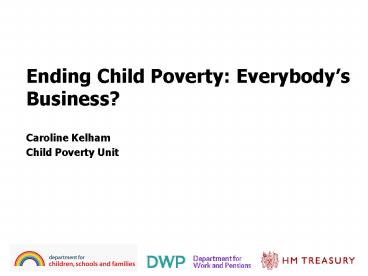Ending Child Poverty: Everybodys Business - PowerPoint PPT Presentation
1 / 27
Title:
Ending Child Poverty: Everybodys Business
Description:
Working with ADCS we have identified some key themes. A vision that is widely shared ... Nursery nurse. Work with us on national policy. Defining the vision and ... – PowerPoint PPT presentation
Number of Views:88
Avg rating:3.0/5.0
Title: Ending Child Poverty: Everybodys Business
1
Ending Child Poverty Everybodys Business?
- Caroline Kelham
- Child Poverty Unit
2
Agenda
1
- The overall picture on child poverty
2
The local role
3
Making it everybodys business
3
- The latest figures were disappointing and show
just how much of a challenge lies ahead
4
Relative poverty figures have risen
5
Stark differences in risk of being in poverty for
different groups (05-07)
- Couples both FT or 1FT
- Lone parents non working
- Couples no working or p/t work
- Large families
- Children lt5
- Disabled adult or disabled child
Getting worse
- Lone parents FT or PT work
- Couples 1FT/1PT
- Older children (11)
- Self employed
- Minority ethnic groups
- Disabled adult and disabled child
Getting better
22
Risk gt than average
Risk lt than average
6
Stark differences in risk for different regions
7
The disappointing trend hasnt played out
everywhere
Change on risk of being in poverty since 03/04
05/06
North West East Midlands Outer London South
East Wales
North East Yorkshire and the Humber West
Midlands South West
East of England Inner London Scotland Northern
Ireland
8
- Growing up in poverty is not inevitable
- We can do something about it
- .but theres a long way to go
9
- Tackling child poverty depends on every local
service playing their part in raising incomes and
improving outcomes - but what does this actually mean in practice?
10
Poverty means so much more than a technical
definition of income
Absolute/relative income poverty
Cultural poverty
?
?
Poverty
Emotional poverty
Social poverty
?
?
Material poverty
11
Our 2020 vision
Working families should see a clear path out of
poverty
Life chances Every child, whatever their
background can achieve the five ECM outcomes
Income
Outcomes
Those who cant work receive the practical and
financial support they need to lift them out of
poverty
Communities Families live in safe, cohesive and
prosperous communities where children can thrive
12
Working with ADCS we have identified some key
themes
A vision that is widely shared
Data used to drive activity and partnerships
Practice based on thorough understanding and
testing of what works
13
What is the local role?
- Services
- Individual professionals what we cant do from
the centre - Relationships with other professionals
- Relationships with service users
- Innovation
14
Local delivery is key to supporting parents to
enter and progress in work
Employment
- Childcare
- Skills and confidence
- Opportunities
- Public sector as employer
15
We need local support alongside national
investment
Financial material support
- Benefit take-up
- Financial management
- Housing
16
Stronger take up of tax credits but much more to
do
Financial material support
- Around 200,000 families on incomes below 20,000
not claiming around 800m in tax credits - Large rise in number claiming help with
childcare, though from a low basebut over a
million eligible families still not claiming - Some minority ethnic groups have lower tax credit
take-up than whites - Indian, Black, Chinese or other
- Take up of in-work Housing Benefit is low
- important following Budget 2008 changes to
increase generosity for families with children
17
Childrens services play a critical role in
breaking the cycle
Life chances
- High quality early years education
- Supporting parents
- Education
18
Tackling deprivation in communities requires
wider involvement
Community deprivation
- Physical space
- Regeneration and planning to stimulate economic
growth - Tackling crime
19
Practitioners will need support to maximise their
contribution
- Partnership working getting better but a long
way to go - Practitioners are moving beyond traditional silos
but need more training and resources - Co-located services are very much valued
- A need for integrated strategies ECM and child
poverty - Importance of stability of targets and sustained
funding
20
Above all, we need innovative solutions to
persistent problems
Police officer
Nursery nurse
GP
Social landlord
Midwife
Health visitor
JCP adviser
Town planner
Teacher
21
Work with us on national policy
- Defining the vision and local role
- Improving our indicators and data sets
- Child poverty pilots
- Inputting to national policy e.g. consultation on
tax credits
22
- Communication is key to emphasise the relevance
of child poverty and facilitate better
partnership working
23
The language we use can be a barrier
- Practitioners do not always immediately
understand the concept of child poverty - Or relate it to their individual role
I dont know much about child poverty its not
my job
Its not the nicest term to be usingits quite
negative
24
How do we get practitioners to the lightbulb
moment?
I can make a difference to the wider goal of
eradicating child poverty I see where my job
fits and I know what more I can do
25
How do we get leaders to the lightbulb moment?
RDAs
Regional Directors
MPs
Policy directors
DCSs
Child Poverty Unit
Local Directors
Regional Ministers
Lead members
Perm Secs
Chief Execs
26
- We need to work together to address these
challenges and provide strategic leadership on
tackling child poverty
27
Over to you.
Caroline.kelham_at_dcsf.gsi.gov.uk

















![NOTE: To appreciate this presentation [and insure that it is not a mess], you need Microsoft fonts: PowerPoint PPT Presentation](https://s3.amazonaws.com/images.powershow.com/6387942.th0.jpg?_=20200719041)













